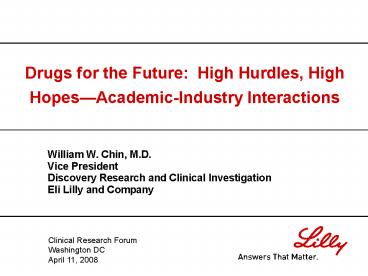Drugs for the Future: High Hurdles, High HopesAcademicIndustry Interactions - PowerPoint PPT Presentation
1 / 14
Title:
Drugs for the Future: High Hurdles, High HopesAcademicIndustry Interactions
Description:
Patients: Most exciting antifolate for solid tumors since the discovery of. methotrexate. Breakthrough therapy for mesothelioma and emerging ... – PowerPoint PPT presentation
Number of Views:51
Avg rating:3.0/5.0
Title: Drugs for the Future: High Hurdles, High HopesAcademicIndustry Interactions
1
Drugs for the Future High Hurdles, High
HopesAcademic-Industry Interactions
- William W. Chin, M.D.
- Vice President
- Discovery Research and Clinical Investigation
- Eli Lilly and Company
Clinical Research Forum Washington DC April 11,
2008
2
from The New Yorker
3
Public and Private Sector Investment in RD
NIH 28B
Pharma 38B
Biotech 10B
4
Improvement of synergy Why?
How?
- Academia/Government
- Major wellspring of new knowledge.
- Expressed desire to translate ideas into
therapies. - Fewer early stage drug discovery funding
opportunities. - Lack of critical drug development
capabilities/capacities.
- Industry
- Mounting environmental pressures.
- Apparent diminished NME output despite expertise.
- Obstacles complex human disease poor animal
models. - Insufficient resources to both find and develop
new targets.
- Potential Solutions
- Collaborative efforts among academia, government
and industry pre-/pro-competitive consortia.
5
Pemetrexed An example of a successful
industry- academia collaboration
- Lilly-Princeton Collaboration (1985-1995)
- Three candidates into clinical development
- Key collaborator at Princeton
- Professor Edward C. Taylor A. Barton
Hepburn Professor - of Organic Chemistry Emeritus and Senior
Research - Chemist - Princeton University
- Synergy between academia excellence and
- (synthetic and heterocyclic chemistry
prowess) - Pharma/Industry know how
- (drug discovery and development expertise)
Professor Edward Taylor
6
Pemetrexed An example of a successful
industry- academia collaboration (2)
- Impacts and Deliverables
- Patients Most exciting antifolate for solid
tumors since the discovery of - methotrexate. Breakthrough therapy for
mesothelioma and emerging - best in class chemotherapeutic for NSCLC (2nd
line). - Benefits for both institutions
- Strong patent portfolio (composition of
matters, synthetic routes, method - of use folic acid, vitamin B12 for mitigating
toxicities of antifolates). - Excellent publications to fuel advanced
research (chemistry, biology, - pharmacology, clinical research) in the field.
- Development of students (Princeton) and
scientists/physicians (LRL). - Effective reward sharing.
- One of the most effective and productive
research collaborations - in Oncology/Lilly Research Laboratories.
- Play the strength of each of the partner.
- Open and swift communications.
7
Potential SolutionsFoster Academic Innovation
and Translational Science
- More active Technology Transfer Offices
- Help create and prepare business plans.
- Introduce technologies to venture capitalists and
corporations. - Academic institution venture programs
- Vanderbilts Academic Venture Capital Fund.
- AM Fund Texas AM University.
8
Lab Bench to Medicine Chest How Medicines Make
it to Market
FUNDING/CONTRIBUTION
Academic Government Labs
Pharmaceutical Companies
AVERAGE TIME TO MARKET 15 YEARS
1.5 Yrs 3.5 Yrs 2 Yrs
1.5 Yrs 6.5 Yrs
FDA REVIEW AND APPROVAL
9
Potential SolutionsFoster Academic Innovation
and Translational Science
- Collaborations with private sector
- New models shared risk/reward.
- Focus on strengths Academiatarget
identification and validation useful animal
models and translational medicine.
Industrydevelopment expertise. - Focus on drug hunting.
10
Translational Medicine Life Cycle
Academic Government Industry Interface
11
Back-ups
12
Three Antifolate Clinical Compounds
Discovered from Lilly-Princeton Collaboration
1st GARFT Inhibitor (Dec, 1986)
LOMETREXOL (DDATHF)
Multi-Targeted Antifolate (Dec, 1990)
ALIMTA
2nd GARFT Inhibitor (Dec, 1994)
GARFT II
13
Centre for Cognitive Neuroscience A New
Partnership Model
Current Academic / Industry Approach
Chemical Tools/ Leads
Mouse and rat cognitive assays
Proof of concept development
Models of disease
In vitro synaptic plasticity
Anatomical validation of behaviour
Functional biomarkers
New Lilly Neuroscience Approach
In vitro synaptic plasticity
Anatomical validation of behaviour
EEG cognition
Innovation Collaboration Competitive advantage
Proof of concept development
Mouse and rat cognitive assays
Functional biomarkers
Models of disease
Drugs
Increasing the speed and reducing the cost by
which laboratory findings are translated into
effective therapies
14
Assays
Perturbations
Tools Targets
Enhanced Target Validation And Translation
Physiological Correlates































